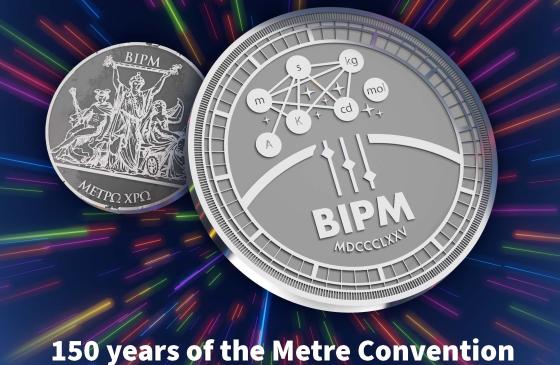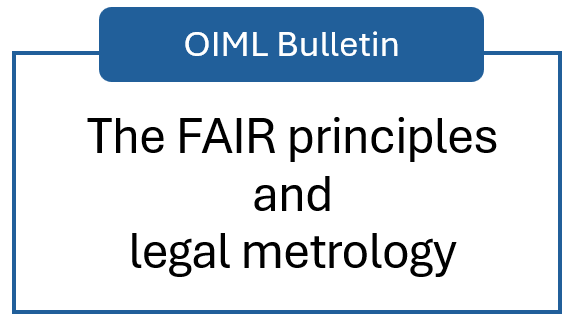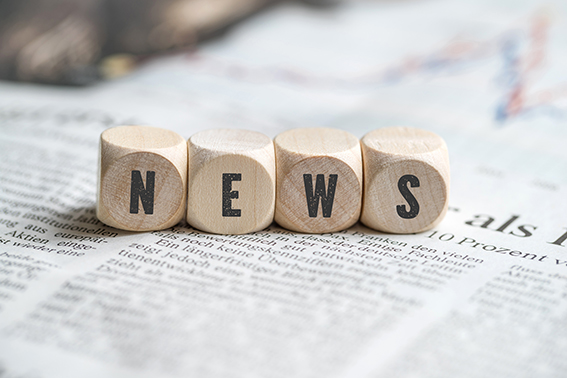OIML BULLETIN - VOLUME LXVI - NUMBER 2 - April 2025
e v o l u t i o n
Digital transparency in legal metrology:
Enhancing accessibility and trust through QR codes and digital solutions
Anna Wonaschütz, João Pedro Santos da Costa and Petra Milota
Federal Office of Metrology and Surveying (BEV) , Austria
Citation: A. Wonaschütz et al. 2025 OIML Bulletin LXVI(2) 20250204
1 Introduction
1.1 Motivation
As important as it is for a well-functioning modern society, legal metrology is often not seen or recognized by the larger public. In Austria, for instance, the initial and subsequent verifications of measuring instruments used to be visible exclusively by means of the verification stamp sealing the instrument against tampering. While this may be a reassuring sign for some consumers and end users, others are less convinced and request additional documentation or inspections from the national authority. In either case, the legal metrology process, as well as the sophisticated measurement, traceable to the International System of Units (SI), remains invisible.
This is also the case for legal metrological control of measuring instruments put on the market in Europe under the Measuring Instruments Directive (2014/32/EU) [1] and the Directive on Non-Automatic Weighing Instruments (2014/31/EU) [2].
The aims of this article are to show how digital transfer of information can:
- facilitate access to information on legal metrological control
- increase trust in measurements under legal metrological control
- improve transparency of proceedings in this context
- increase visibility of legal metrology
- contribute to the information and education of the general public on the public purpose and benefit of legal metrological control
In this article, we will show how a simple app makes the national process of initial and subsequent verifications more transparent in Austria. We will present how this digitalization project at the Federal Office of Metrology and Surveying (BEV) has delivered practical results [3] and how this could be extended to measuring instruments placed on the market through the two mentioned EU directives.
We will summarize how measuring instruments are placed on the market in Europe and which information is currently transferred to the consumer or end user. We will point out room for improvement and show how digitalization of public services can be used to realize this improvement.
1.2 Building trust through digital access to information
Providing access to measurement data through digital solutions offered by authorities or official institutions helps build trust. When users know that verification and calibration data originate from an authorized source, they are more likely to rely on its accuracy and authenticity.
Austria has taken a major step towards digitalization in the management of measuring instruments by introducing a system that allows instant access to national verification and calibration data via QR codes (Figure 1). This innovation, implemented through the Test Equipment Management Application (MMAPP) and the Test Equipment Verification Information System (MMEII) [3], enhances efficiency, reduces administrative workload, and improves transparency for businesses, institutions, and the public.

Figure 1. MMEII/MMAPP QR Code on instruments, information directly on the mobile device.
Even as machine-readable data becomes more prevalent, human readability remains crucial – especially in the field of verification, where precision and credibility are equally important. By scanning the QR code, users can directly read calibration certificates and obtain human-readable information on verifications. A transparent system such as MMAPP ensures that users, from industry professionals to consumers, can confidently access up-to-date measurement data without concerns about accuracy or data integrity.
We believe that this system could also be of use for the procedures used to place measuring instruments on the market according to the directives.
2 Legal metrology in EU directives on measuring instruments
2.1 Placing measuring instruments on the market in Europe
Measuring instruments in the European Union have to fulfil the requirements of the Directives (2014/32/EU) [1] and (2014/31/EU) [2] if the EU member state has defined in its legislation that they are subject to legal metrological control (e.g. initial and possibly subsequent verifications). Examples of instruments covered by these directives are meters for gas, water, electricity and thermal energy, weighing instruments, length measuring instruments of various kinds, measuring systems for liquids other than water, taximeters, and capacity serving measures.
The compliance of a measuring instrument with these directives is determined in a conformity assessment procedure, usually carried out by a designated conformity assessment body – the “notified body”. The conformity assessment procedure can take different forms (“modules”, in the terminology of the directives) and involves technical testing of the instruments and/or prototypes, or assessments of the instrument manufacturer’s quality assurance systems. In all cases, the metrological control of the measuring instrument through traceable calibration is part of the process.
Instruments that have been found to fulfil the requirements of the applicable directive carry the conformity marking (Figure 2): a CE marking, the supplementary metrology marking and, if applicable, the 4-digit identification number of the notified body.

Figure 2. Example of a conformity marking.
Once the instrument is placed on the market, it is recognized as compliant with the directive in all EU member states; additional initial verification procedures are obsolete. In the continuing operating life of the instrument, subsequent verifications and in-service inspections may be carried out in each member state according to national legislation.
2.2 Information transfer to the consumer and (in)visibility of legal metrology
Once on the market, the most recognizable marking on the instrument is the CE marking. Consumers are familiar with its appearance on a large number of different products because it designates conformity with many EU directives and regulations, not just those on measuring instruments. In contrast, the meaning of the metrology marking and the identification number of the notified body (Figure 2) is often not understood. Through the identification number, the involved notified body and its scope of notification can be traced. The metrology marking designates the instrument as under legal metrological control, but this meaning, as well as its connection to sophisticated and reliable measurements that are traceable to the SI, is not a part of general knowledge.
Aside from the conformity marking, information is also transferred to the user or consumer by the EU declaration of conformity. It is issued by the manufacturer and contains necessary information to allow product traceability, required information declaring the manufacturer’s responsibility for conformity, and concise information on the legal procedure and its technical background. This latter information – lists of harmonized standards or references to technical specifications; the module chosen to establish conformity; the name, number and certificates of the notified body – pertains to legal metrology: The certificates of the notified body and the declaration of conformity are issued on the basis of measurement reports, which contain information on traceability to the SI, but this is unclear to anyone unfamiliar with the modules.
Nonetheless, consumers are interested in whether their electricity meter reading is accurate, whether they paid the correct fare for their taxi ride, or if they are served the full 0.25 l of drink they are being charged for. Often, they are familiar with the concept of verification, but are unaware of the conceptual connection between this process and the conformity marking. As a result, legal metrology institutes and authorities regularly receive requests inquiring about the verification status or correctness of measuring instruments. Just as for the national verifications, there are sometimes requests for certificates, measurement data or other forms of further evidence, even though the metrological control and successful conformity assessment are evident to the trained eye by the clear and indelible conformity marking.
2.3 Access to information on legal metrology
Gaining access to the information on the legal metrology behind the conformity marking is time-consuming. If the consumer has no prior knowledge, the educational work required to elucidate the meaning of the conformity marking and to interpret the declaration of conformity may possibly be accomplished through skilful research and correct assembly of publicly available information. It is, however, somewhat unlikely that the consumer is willing to go through this research and trust their own conclusions, rather than to contact the national authority responsible for verifications.
Assuming that the consumer has, or has successfully gained, the required knowledge, there are still obstacles. The declaration of conformity is legally required to be provided with the instrument upon delivery to the end user (for example, the electricity provider), but not necessarily the consumer (who is required to pay the electricity bill). Tracing the notified body, including the scope and validity of its notification on the appropriate website (NANDO - New Approach Notified and Designated Organisations Information System [4]), is possible, but not fast. The certificates issued by a notified body may or may not be publicly available. Declarations of conformity and certificates of notified bodies are often issued as electronic documents (PDFs), and either sent by mail or generated through websites. In some cases, they are still issued as paper documents.
Last, but not least, if only the declaration of conformity is available to the consumers, they are asked to solely trust the manufacturer declaring their compliance with EU directives. The role of the notified body as an independent third party and the associated trust in legal metrological control is obscured by the lack of direct information transfer.
In conclusion, while both the conformity marking and the declaration of conformity contain information on legal metrological control and designate its validity, the meaning is most likely lost to the majority of consumers and end users due to the lack of easy access to information.
We have identified the following information linked to legal metrological control that is worth transferring to the general public more directly in order to improve trust in legal metrology:
- the meaning of the metrology marking;
- the meaning of “metrological control” and the fact that the measurement is traceable to the SI;
- information on which measurement value (if the instrument has more than one function) is under metrological control;
- the role of the notified body;
- the scope of its notification; and
- possibly information on required subsequent verifications, which are outside the scope of the two EU directives, but of great interest to the user.
While all of this information is, in principle, publicly available, easy access to this type of annotated information, elucidation of terminology and the meaning of specialized concepts could greatly reduce the time and effort spent both by consumers and national authorities clarifying requests. In addition, a better and quicker understanding of the meaning of the conformity marking can improve trust in transparent and accountable public institutions. Finally, legal metrology and the reliable efforts going into its maintenance become more visible.
3 Improving visibility and transparency through digitalization
3.1 The need for digital transformation
There is a growing need for easily accessible verification systems which are clear, easy to use, and readily available, as highlighted by input from industry players, testing organizations, and government agencies. Currently, consumers often find themselves without user-friendly insight into verification information, putting their faith in manufacturers' assurances of compliance. The need for readily accessible and trustworthy data is on the rise, especially since regulatory bodies overseeing measurement standards are constantly fielding questions regarding the verification history of measuring devices.
A crucial element of Europe's digital shift is the creation of the Digital Product Passport (DPP) [5]. This initiative seeks to furnish standardized, machine-interpretable product information, boosting transparency and accountability throughout a product's entire life cycle. The DPP is intended to serve as a repository for essential product details, including sustainability metrics, regulatory adherence documentation, and technical blueprints. The future holds great potential for the DPP to be enhanced by incorporating machine-readable verification certificates. This integration would streamline access to legal metrology information, enabling both consumers and regulatory bodies to quickly and effortlessly confirm a product's adherence to standards, eliminating the need for paper documentation or time-consuming manual inquiries.
A hurdle for incorporating digital verification certificates into the DPP stems from differing re-verification timelines among EU countries [6]. Each country has its own schedules for these follow-up checks. Thus, a measuring device compliant in one nation could require reverification earlier in another. If these digital certificates were part of the DPP, systems would need to precisely reflect these country-specific validity periods. This could complicate mutual recognition of metrological compliance across borders and bring up issues regarding uniformity within the EU’s legal metrology system.
The National Metrology Institute of Austria (Federal Office of Metrology and Surveying, BEV) has already taken significant steps in enhancing visibility and accessibility of verification data through the MMEII (Test Equipment Verification Information System) customer portal. This platform allows consumers to access digital verification certificates via QR codes, providing instant confirmation of a measuring instrument’s validity. Applying this principle more broadly could further empower consumers, enabling them to retrieve declarations of conformity digitally. This would be particularly beneficial for cross-border transactions, as it could allow Austrian consumers to access conformity declarations issued by foreign authorities in a standardized, user-friendly format.
The overarching goal of digital transformation in legal metrology is to strengthen user experience and consumer trust. By leveraging technologies such as the Digital Product Passport and integrating machine-readable compliance data, authorities can ensure that verification and conformity processes are more transparent, efficient, and accessible to all stakeholders.
3.2 QR codes and web applications for seamless access
The integration of QR codes on all measuring instruments verified at BEV provides a simple and direct method for accessing relevant calibration and verification data. Users can scan the QR code at any time to retrieve publicly available verification information without authentication.
The MMEII system provides:
- verification status: Instant access to the current verification status of the measuring device;
- random sample data: Insights into random sampling procedures and results.
This solution overcomes the long-standing challenge of critical verification information being not directly visible on the device itself. With this digital system, users can retrieve all relevant details – such as manufacturer, calibration authority, date of last verification, and validity period – without requiring physical labels or additional paperwork. The MMAPP system mentioned in Section 1.2 offers extended functionalities to authorized users, such as companies, so they can:
- manage measuring instruments efficiently,
- schedule calibrations and verifications,
- monitor deadlines and compliance requirements and
- access structured reports and detailed documentation.
The user-friendly interface allows instruments to be organized by location, laboratory assignment, or verification status, ensuring a streamlined workflow. Additionally, the system supports structured data provision, enabling automated integration into ERP systems and internal reporting tools, reducing manual administrative work and improving data accuracy.
In the near future we intend to extend the MMEII system on a voluntary basis to the measuring instruments placed on the market through the two EU directives by providing concise additional information such as the points listed in Section 2.3.
Attaching a QR code on instruments is possible for procedures in which instruments are directly tested by a notified body (modules F, F1, G). It may be more challenging to establish a procedure to do this for modules in which the manufacturer’s quality control system is assessed, as the notified body has no direct access to the instruments.
3.3 Challenges of practical implementation
In implementing the MMEII system, we also recognized the potential challenges posed by such an undertaking. Currently, Austria has approximately 5.5 million electricity meters, with a total of around 10 million measuring devices in use. However, only 1.3 million meters are verified each year. This means, it would take 10 to 15 years for all devices to be gradually added to the MMEII system.
Recognizing that customers may hesitate to use the system if they cannot find their devices within the MMEII system, BEV engaged in discussions with Austria’s largest energy suppliers. Their response was overwhelmingly positive: to accelerate adoption, these suppliers agreed to upload all their measuring devices into the database, even those that have not yet undergone official verification.
To maintain transparency, a disclaimer will clearly indicate which devices have not yet been verified by an official authority. Despite this, suppliers are eager to participate because they recognize that customers place greater trust in BEV as an official body than in the energy providers themselves. This approach ensures a rapid expansion of the database, improving usability and adoption rates.
A key goal ensuing from the collected insights and experiences is to ensure that measurement data are not only available in machine-readable formats but also easily readable and understandable for end users. Many individuals and businesses lack technical expertise but still need to work with verification and calibration data.
By embedding QR codes that directly link to relevant verification information, the system enables a wide audience to access the necessary data without significant barriers. This approach ensures that digital transformation does not exclude non-technical users but rather empowers them with a user-friendly way to retrieve essential measurement data.
4 Benefits and conclusions
The introduction of digital solutions can significantly improve the management of measuring instruments and their verification processes. The integration of the MMAPP and MMEII systems at BEV represents a forward-thinking approach to measurement data management. By leveraging modern web technologies and mobile applications, a scalable and always-available solution is provided to end-users and consumers.
Instead of relying on time-consuming personal inquiries at national authorities, users can retrieve and manage their data instantly. This digital transformation leads to:
- faster, real-time access to calibration and verification reports
- significant reduction of administrative workload
- reduced reliance on paper documentation
For MMAPP users, the benefits extend to:
- improved efficiency in measurement management
- seamless integration with existing business processes and digital systems
- improved planning and scheduling of maintenance and re-verification deadlines
- reduction of administrative workload through automation and integration with ERP systems
We see great benefits in the potential extension of these systems to the procedures of the EU Directives on measuring instruments and non-automated weighing instruments. Here, the benefits also serve a more general educational purpose by making legal metrology more visible to the consumers. We expect that the digitalization of the information will lead to
- a more efficient dissemination of relevant information on the verification status of the instruments
- improved understanding of the meaning of the conformity marking and the role of the notified body
- improved visibility of traceability to the SI
- increased trust in measurements
- increased trust in both national authorities and the harmonized European process
- a better understanding of the role of legal metrology in the procedures that place measuring instruments on the market in Europe
Austria's approach may serve as an inspiration to integrate accurate and reliable verification processes into digital workflows while ensuring and improving accessibility of important information to the consumers. The continued development of such digital solutions will lead to greater transparency and accountability of public services.
References
[1] Directive 2014/32/EU of the European Parliament and of the Council of 26 February 2014 on the harmonisation of the laws of the Member States relating to the making available on the market of measuring instruments. EUR-Lex. [Online]. Available: https://eur-lex.europa.eu/legal-content/EN/TXT/HTML/?uri=CELEX:32014L0032. [Accessed: 2 Oct. 2025].
[2] Directive 2014/31/EU of the European Parliament and of the Council of 26 February 2014 on the harmonisation of the laws of the Member States relating to the making available on the market of non-automatic weighing instruments. EUR-Lex. [Online]. Available: https://eur-lex.europa.eu/legal-content/EN/TXT/HTML/?uri=CELEX:32014L0031. [Accessed: 2 Oct. 2025].
[3] Measuring Instruments BEV – Federal Office of Metrology and Surveying. [Online]. Available: https://www.bev.gv.at/en/Press/News/Measuring-Instruments.html. [Accessed: 2 Oct. 2025].
[4] NANDO (New Approach Notified and Designated Organisations ) Information System on Notified Bodies. European Commission. [Online]. Available: https://webgate.ec.europa.eu/single-market-compliance-space/notified-bodies. [Accessed: 2 Oct. 2025].
[5] EU’s Digital Product Passport: Advancing Transparency and Sustainability. Data.europa.eu. [Online]. Available: https://data.europa.eu/en/news-events/news/eus-digital-product-passport-advancing-transparency-and-sustainability. [Accessed: 2 Oct. 2025].
[6] Country Information | WELMEC WELMEC. [Online]. Available: https://www.welmec.org/legal-metrology-information/country-information. [Accessed: 2 Oct. 2025].






